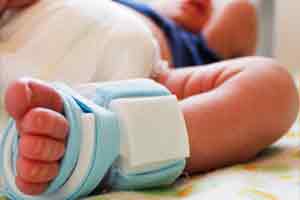Over-Reliance of Pulse Oximetry for Children With Respiratory Infection
 Among infants presenting to a pediatric emergency department with mild to moderate bronchiolitis, those with an artificially elevated oxygen saturation reading were less likely to be hospitalized or receive hospital care for more than 6 hours than those with unaltered readings, suggesting that these readings should not be the only factor in the decision to admit or discharge, according to a study in the August 20 issue of JAMA.
Among infants presenting to a pediatric emergency department with mild to moderate bronchiolitis, those with an artificially elevated oxygen saturation reading were less likely to be hospitalized or receive hospital care for more than 6 hours than those with unaltered readings, suggesting that these readings should not be the only factor in the decision to admit or discharge, according to a study in the August 20 issue of JAMA.
Bronchiolitis, a viral lower respiratory tract infection, is the leading cause of infant hospitalizations in the United States, with annual costs in excess of $1 billion. Between 1980 and 2000, the rate of hospitalizations for bronchiolitis more than doubled. Pulse oximetry, which involves an instrument usually attached on the finger or ear lobe, is a noninvasive method of measuring oxygen saturation, and its routine use has been associated with changes in the management of bronchiolitis. There is no evidence that certain cutoff measurements predict progression from relatively mild to severe bronchiolitis, according to background information in the article. “If well-appearing children with mild to moderate bronchiolitis can be sent home, fewer hospitalizations and lower health care costs could result.”
Suzanne Schuh, M.D., F.R.C.P.C., of The Hospital for Sick Children, Toronto, and colleagues conducted a randomized clinical trial to determine if increasing the displayed oximetry reading three percentage points above the true values would decrease the probability of hospitalization within 72 hours or hospital care for greater than 6 hours. The study included 213 otherwise healthy infants 4 weeks to 12 months of age with mild to moderate bronchiolitis in a tertiary-care pediatric emergency department in Toronto.
The researchers found that 41 percent (44/108) of children in the true oximetry group were hospitalized within 72 hours, compared with 25 percent (26/105) in the altered oximetry group. There were 23 of 108 (21.3 percent) subsequent unscheduled medical visits for bronchiolitis in the true oximetry group and 15 of 105 (14.3 percent) in the altered oximetry group.
“Artificially increasing the oximetry display in emergency department patients with mild to moderate bronchiolitis by a physiologically small amount significantly reduced hospitalizations within 72 hours or active hospital care for more than 6 hours compared with infants with unaltered oximetry readings. This conclusion also held true after adjustment for other variables significantly associated with this outcome. Because the groups had similar severity and the adjustment for the experimental saturation resulted in lack of primary treatment effect, the difference in displayed saturations was likely the primary reason for the observed reduction in hospitalizations,” the authors write.
The researchers add that these findings suggest “that oxygen saturation should not be the only factor in the decision to admit, and its use may need to be re-evaluated.”
Bronchiolitis, Deception in Research, and Clinical Decision Making
In an accompanying editorial, Robert Vinci, M.D., of the Boston University School of Medicine, and Howard Bauchner, M.D., Editor in Chief, JAMA, comment on the findings of this study.
“… it is now clear that the oxygen saturation reading can influence decision making in ways that many clinicians have thought likely—overreliance on physiologic information of uncertain importance derived from a medical device. While physicians seek to improve the science of clinical decision making, the art of medicine and clinical assessment should not be trumped by overreliance on a single physiologic parameter. The care of patients with bronchiolitis will continue to improve as experienced physicians emphasize and continue to use a complete clinical evaluation and assessment as the most important element in the care of these infants and children.”
Source Newsroom: JAMA – Journal of the American Medical Association
Citations
JAMA

